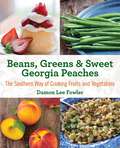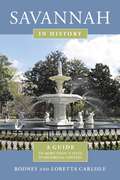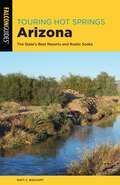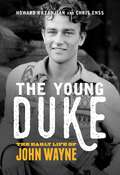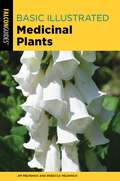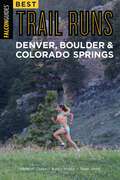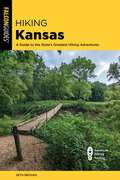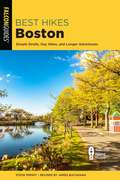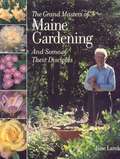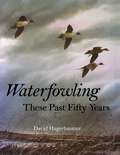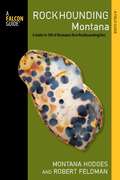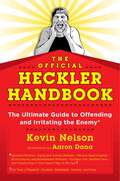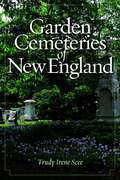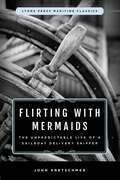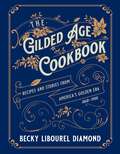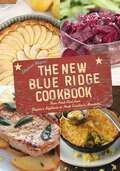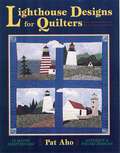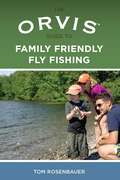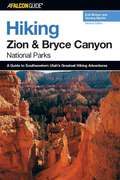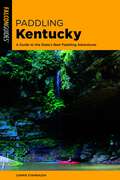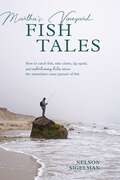- Table View
- List View
Beans, Greens & Sweet Georgia Peaches: The Southern Way of Cooking Fruits and Vegetables
by Damon Lee FowlerThink of Southern fruits and vegetable, and tomatoes, corn, okra, and watermelon come to mind. But what about grapefruits, oranges, and key limes from Florida? Or peas, beans, and greens from the fields of Mississippi? In Beans, Greens & Sweet Georgia Peaches, Damon Lee Fowler, who is passionate about preserving Southern culinary traditions, offers recipes for transforming Vidalia onions, sun-ripened tomatoes, field peas, butterbeans, sweet potatoes, Georgia Peaches, plump figs, watermelons, key limes, and Florida citrus into fruit and vegetable glories of the Southern table.
Savannah in History: A Guide to More Than 75 Sites in Historical Context
by Rodney Carlisle Loretta CarlisleSavannah in History features over 90 sites in Savannah, Georgia, presented organized by historical era, with over 100 color photos.This presentation is especially important for a city with a long and varied history like Savannah, where colonial sites are virtually next door to antebellum, Civil War, and important modern sites. This guidebook conveys a clear picture of the evolution of the city from its beginnings to the present and helps the tourist, and even the resident, unravel and understand the dozens of historic buildings and monuments and several excellent museums. Like the others in this series on St. Augustine, Key West, Charleston, and Tampa, it serves as both a guidebook and keepsake.
Touring Hot Springs Arizona: The State's Best Resorts and Rustic Soaks
by Matt C. BischoffWhether you're seeking a soak in naturally heated mineral water or out for a sightseeing adventure, this fully updated and revised color edition of Touring Hot Springs Arizona guides you to the best sites for soaking in the beauty of the region. Historian and veteran outdoors author Matt Bischoff reveals his favorite "hot spots," from primitive pools in the backcountry to handcrafted bathhouses surrounded by civilization.
The Young Duke: The Early Life of John Wayne
by Chris Enss Howard KazanjianBy the time Stagecoach made John Wayne a silver-screen star in 1939, the thirty-one-year-old was already a veteran of more than sixty films, having twirled six-guns and foiled cattle rustlers in B Westerns for five studios. By the 1950s he was Hollywood&’s most popular actor—an Academy Award nominee destined to become an American icon. This biography reveals the story of his early life, illustrated with rare archival images.
Acadia's Carriage Roads
by Robert ThayerThe third title in the Acadia National Park guide series, Acadia's Carriage Roads covers the history, geology, and biology of the area. It includes practical advice and maps to help visitors get the most from their tours of the roads, whether on foot, by bicycle, or on cross-country skis. With their work-of-art stone bridges, these crushed-rock carriage roads — the result of decades of effort by philanthropist John D. Rockefeller Jr. — are known throughout the world for their beauty.
Basic Illustrated Medicinal Plants (Basic Illustrated Series)
by Jim Meuninck Rebecca MeuninckAn information-packed tool for the novice or handy reference for the veteran. Distills years of knowledge into an affordable and portable book. With this guide, you'll discover how to identify medicinal plants in the contiguous United States.
Best Trail Runs Denver, Boulder & Colorado Springs
by Peter Jones Nancy Hobbs Adam W. ChaseBest Trail Runs Denver and Boulder features forty of the best trail runs within an hour of both cities—complete with color photos, maps, and detailed specs and trail descriptions, as well as GPS coordinates for all trailheads. Sidebars throughout the book highlight useful information about local restaurants, lodging, entertainment, and other amenities, as well as information about local running clubs, outdoor retail shops, and more. More than just a &“where-to&” guidebook to the best trail runs in and around these urban areas, Best Trail Runs Denver and Boulder includes vital information on warm-up exercises for each area&’s specific terrain, as well as hazards in the area (and how to prepare for them), and the best seasons to run which trails. Full of inspirational photos throughout, this book also includes practical maps and must-see features along the way.
Hiking Kansas: A Guide to the State's Greatest Hiking Adventures
by Seth BrooksHiking Kansas introduces hikers of all abilities to 40-45 of the greatest hiking adventures across the state. Complete with thorough hike descriptions, mile by mile directional cues, detailed maps and useful information on the surrounding area there is something for every hikers. Between rolling prairies, wooded river valleys, and an abundance of wildflowers and wildlife, a wealth of natural beauty awaits you on the hiking trails of Kansas.
Best Hikes Boston: Simple Strolls, Day Hikes, and Longer Adventures
by Steve MirskyWho says you have to travel far from home to go on a great hike? In Best Hikes Boston reviser James Buchanan details the best hikes within an hour's drive of the greater Boston area, perfect for the urban and suburbanite hard-pressed to find great outdoor activities close to home. Each featured hike includes detailed hike specs, a brief hike description, trailhead location, directional cues, a detailed map, and color photos.
The Grand Masters of Maine Gardening
by Jane LambJane Lamb has been a major contributor of gardening articles to Down East magazine for nearly 20 years. Now 27 of her articles profiling Maine's premier gardeners and most outstanding gardens are collected in one volume. Jane has provided a new introductory paragraph for each chapter to bring readers up to date on what has changed since the time when the original article was published. The book includes how-to advice about gardening in a northern climate and insight into ways to approach garden design, as well as 55 color photos by noted garden photographers.
101 Hearty Recipes
by Gooseberry PatchYour family will happily gather 'round the table when you pass around the homestyle dishes in 101 Hearty Recipes! Because some days are busy and other days are more relaxed, you'll love the two full chapters of mains and side dishes that satisfy. Recipes in Speedy & Satisfying like Cheesy Chicken & Bacon Casserole and Au Gratin Sausage Skillet come together in a snap…just 30 minutes or less! Homemade suppers in Casual & Comforting like German Style Short Ribs and Golden Parmesan Roasted Potatoes are slowly-simmered or baked until bubbly and guaranteed to be worth the wait. Other tempting delights include Raspberry Upside-Down Cake and Dark Chocolate Pecan Pie…talk about comfort food! Homemade presents are always the best, so we've tucked in recipes just perfect for gift-giving all year long! Durable softcover, 112 pages.
Waterfowling These Past Fifty Years
by David HagerbaumerThis waterfowling classic recounts the esteemed artist and skilled duck hunter David Hagerbaumer&’s half century of experiences hunting brant and other species along the Pacific Coast. Since his early days on the marsh in the 1920s, Hagerbaumer perfected the art and sport of waterfowling both painting wood ducks and mallards and hunting every sporting bird species across North America. He especially appreciated the black brant of the Pacific, saying they symbolized all that is wild and free. In this recognized classic Hagerbaumer has compiled his best-loved stories and recollections of waterfowl hunting and accompanies the text with his fine illustrations.
Rockhounding Montana: A Guide to 100 of Montana's Best Rockhounding Sites (Rockhounding Series)
by Robert Feldman Montana HodgesWith this informative, fully updated and revised guide, you can explore the mineral-rich region of Montana. It describes the state's best rockhounding sites and covers popular and commerical sites as well as numerous little-known areas. This handy guide also descirbes how to collect specimens, includes maps and directions to each site, and lists rockhound clubs around the state. This is truly a complete guide to popular collecting sites in Montana and source-book brimming with advice that can be of use to both the novice and the experienced rockhounder.
Hiking Maryland and Delaware: A Guide to the States' Greatest Hiking Adventures (State Hiking Guides Series)
by Terry CummingsHiking Maryland and Delaware explores 56 easy-to-follow, and easy-to-get-to hikes. Weaving the natural history and rich cultural history of two of our nation's oldest states, the author guides you through the rugged mountains, old-growth hardwood forests, salt-marsh wildlife preserves, and Piedmont stream valleys that attracted settlers to the region more than three centuries ago.
The Official Heckler Handbook: The Ultimate Guide to Offending and Irritating the Enemy
by Kevin NelsonAny sports fan can yell offensive and stupid things at anyone else. But only the best are true hecklers, game-changers as valuable in their way as LeBron James is to the Cavaliers or TomBrady to the Patriots. The Official Heckler Handbook is the essential book for and about hecklers and for all fans ready to make a real difference on behalf of their teams and their players. Packed with outrageous illustrations, can&’t-miss sidebars, real-life anecdotes, and expert advice, this book breaks down:• Great moments in heckling history • The best hecklers of all time • Heckling in baseball, football, basketball, hockey, and more • The most effective lines of attack • Strategic heckling locations • Verbal and nonverbal heckling • And much, much moreSo, turn around and read this book with your good eye! And learn how to be among the best in the boo-bird business.
Garden Cemeteries of New England
by Trudy Irene SceeIn 1831 a new entity appeared on the American landscape: the garden cemetery. Meant to be places where the living could enjoy peace, tranquility and beauty, as well as to provide a final resting place for the dead, the garden cemeteries would forever change the culture of death and burial in the United States. The ideal cemetery would become one in which ornamental trees, bushes, flowers, and waterways graced the ever more artistic (for those who could afford them) monuments to the dead. Previous to the 1830s, the deceased were buried in church lots, in small and soon overcrowded public lots, and even, occasionally in backyards and fields. Graves were often untended, weeds and decay soon took over, and the frequently used wooden grave markers rotted away. Some turned to a movement emerging in Europe, in which horticulture was starting to become a factor in cemetery planning, at a time in which cemetery planning itself was a novel idea. New England was the first region in America to take up the new ideals.The first such cemetery, Mt. Auburn, opened in Cambridge, Massachusetts, in 1831, and Mount Hope Cemetery, in Bangor, Maine, followed in 1834. Today, these cemeteries are both beautiful places to visit and important historical sites. The author takes readers on a historical tour of eighteen of the Northeast's garden cemeteries, exploring the landscape architecture, the stunning beauty, and delving into the rich history of both the sites and of those who are buried there.
Flirting with Mermaids: Lyons Press Maritime Classics
by John KretschmerOver the course of twenty years of delivering sailboats to far-flung quaysides, John Kretschmer has had innumerable adventures, both humorous and terrifying. In Flirting with Mermaids, he recounts the most memorable of them.He crosses the Western Caribbean with a crew of eccentric Swedes researching ancient Mayan mariners, lands in Aden at the outbreak of civil war, and endures a North Atlantic crossing during which he discovers the existence of Force 13 winds. Approaching Japan at the end of a particularly trying delivery, he finds himself sailing in "a high impact debris zone," but his resolve is unshaken. "If a piece of rocketship jetsam fell out of the sky and sank [me] after encounters with Hurricane Floyd, General Noriega, a tsunami, an erupting volcano, and Typhoon Roy, then it was meant to be."
Gilded Age Cookbook: Recipes and Stories from America's Golden Era
by Becky Libourel DiamondThe American Gilded Age (1868 to 1900) and its extreme extravagance continue to be a source of wonder and fascination, particularly for foodies. The style and excessiveness of this era has ties to modern popular culture through books, films, and television shows, including The Alienist and the Julian Fellowes TV series The Gilded Age, on HBO. The Gilded Age Cookbook transports the reader back in time to lavish banquet tables set with snow-white linen tablecloths, delicate china, and sparkling crystal glasses. Cuisine featuring rich soups, juicy roasts, and luscious desserts come to life through historic images and artistic photography. Gilded Age details and entertaining stories of celebrities from the era—the Vanderbilts, Astors, Goelets, and Rockefellers—are melded with historic menus and recipes updated for modern kitchens.
The New Blue Ridge Cookbook: Farm Fresh Food from Virginia's Highlands to North Carolina's Mountains
by Elizabeth WiegandMore than 100 recipes, both old and new, celebrating the regional foods of the Blue Ridge Mountains.
Lighthouse Designs for Quilters
by Pat AhoTwelve Maine lighthouses inspired the quilt block designs in this collection, mostly done in hand applique. The author includes interesting short histories of the lights along with her always lucid, simple directions and diagrams for making the blocks. She also includes a variety of attractive nautical-related quilting patterns for the final stitching, and provides directions for ways to use the quilt blocks on smaller projects as alternatives to combining them into a quilt.
Orvis Guide to Family Friendly Fly Fishing (Orvis)
by Tom RosenbauerThe Orvis Book of Family Friendly Fly FishingLike all sports, the fun of fly-fishing lies in sharing the experience and in spending time with those closest to you. And yet for a father unsure how to connect with his bored, PlayStation-dazed kids, for a beginning fisherman who doesn’t want to learn casting techniques by himself, for a mother who would love to show her children the outdoors but isn’t quite sure how to begin, it can be a frustrating and intimidating business.From one of the most trusted brands in the industry, and from one of the sport’s most esteemed authors, The Orvis Guide to Family-Friendly Fly-Fishing by Tom Rosenbauer will take the mystery out of sharing the experience.Rosenbauerprovides instructional guidance, discusses the nuts and bolts of casting, fly choice, and technique, and opens the lens to discuss family-friendly destinations, gear, schools, safety, and more.Rosenbauer brings his expertise to bear on perhaps the most essential skill set of all—introducing the people closest to you to your beloved sport.Tom Rosenbauer, host of the Orvis Fly Fishing Podcasts, has been with the Orvis Company over 30 years. Rosenbauer is Fly Rod & Reel magazine's 2011 Angler of the Year and author of The Orvis Fly-Fishing Guide, one of the best-selling fly-fishing books ever.
Hiking Zion and Bryce Canyon National Parks (Regional Hiking Series)
by Erik Molvar Tamara MartinThoroughly updated and revised, this guide covers fifty-six hikes in the two featured parks as well as the surrounding areas--Cedar Breaks National Monument, the Markagunt high country, and the Paunsaugunt area.
Paddling Kentucky: A Guide to the State's Best Paddling Adventures (Paddling Series)
by Carrie StambaughKentucky&’s waters hold a wealth of riches, and Paddling Kentucky features forty of the best river and trips for avid paddlers, floaters, and anglers. With detailed route descriptions and information on put-in and take-out points, as well as gorgeous photography and maps, this guide is the only book you need to get out on the water and enjoy the Bluegrass State!
101 Easy Everyday Recipes
by Gooseberry PatchWho doesn't love a meal that's simple to shop for and comes together in a snap? That's exactly what you'll find in 101 Easy Everyday Recipes. Your family will savor most-requested recipes like Coconut-Orange Breakfast Rolls, Apple Crisp Pie, Down-Home Taco Casserole and Unstuffed Green Pepper Soup. And with a photo of every recipe, you'll know just what to expect, making menu planning a breeze!
Martha's Vineyard Fish Tales: How to Catch Fish, Rake Clams, and Jig Squid, with Entertaining Tales About the Sometimes Crazy Pursuit of Fish
by Nelson SigelmanThe focus is on Martha&’s Vineyard but the information, fishing tips, and stories about Island characters—Bob &“Hawkeye&” Jacobs jumping off Memorial Wharf to unsnag an albie he hooked—will sound familiar to anyone who has spent time in a community of fishermen.This informative and fun read answers the questions asked in local tackle shops, including the best spots to catch a striped bass on a fly rod—Lobsterville Beach—and rigging tackle for blues, fluke, black sea bass, false albacore, and bonito. Spin fishing, bottom fishing, and fly fishing are all covered.This book follows the island fishing seasons: rods appear on island trucks in April, a sign that schoolies have arrived, and they do not begin to disappear until the venerable Bass and Bluefish Derby, five weeks of single-minded pursuit of fish, ends in October. And there are tips on looking and talking the part . . . &“handy phrases include any reference to a falling or rising tide and a rock, any rock, as long as you refer to it with a sense of authority so that the other person is unwilling to ask which rock for fear of seeming like a novice.&”Martha&’s Vineyard Fish Tales is a&“how to&” book that flows with the character and personality of a fishing-obsessed island off the coast of Massachusetts.
